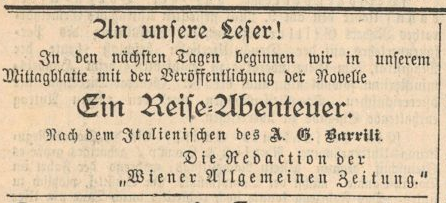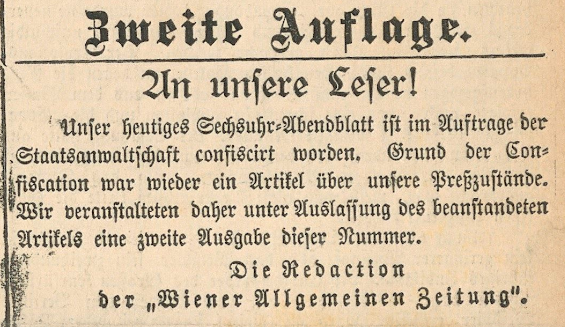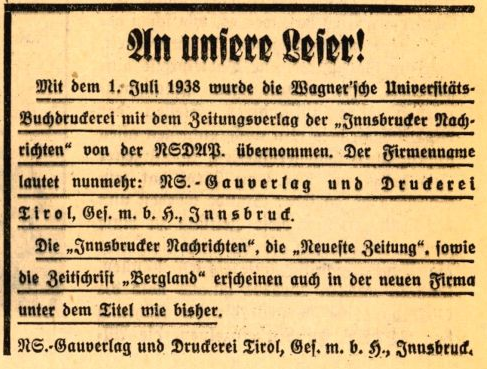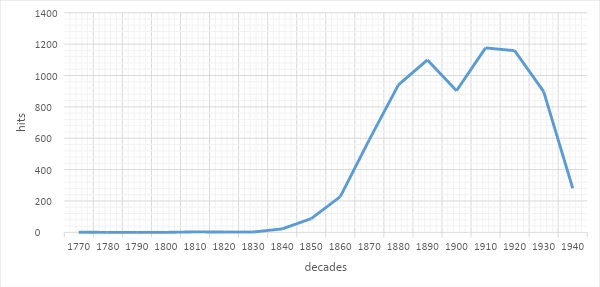By Benedikt Kapferer, University of Innsbruck
Along with other major historical phenomena such as industrialisation, urbanisation, migration or modernisation, the “long 19th century” also witnessed the rise of newspapers as mass media. Especially from the 1850s onwards, they contributed to shaping new forms of public spheres and consequently played a key role in constructing modern nation-states. Newspapers and media production in general fundamentally depended on political, social, economic and technological developments. In particular, the political dimension with the gradual introduction of more liberal press laws as well as the technological dimension with innovations in the printing process had a large impact on the production, distribution and reception of newspapers (Requate 2009; Telesko 2010). In Austria-Hungary the legislation of the 1860s, the rise of major political parties in the 1890s and the abolishment of the “Zeitungsstempel”, a kind of media tax, in 1900 led to a proliferation of the entire media landscape. During this period of the second half of the 19th century, newspapers consolidated their dominance as mass media (Bösch 2019; Melischek/Seethaler 2016; Olechowski 2006). In order to gain insight into the significance of newspapers as a medium and the emergence of journalism as a profession, it is necessary to investigate the specific social and technological practices of the time.
Interaction between Newspapers and their Readers
In today’s age of digitisation and the internet, interaction and participation are major characteristics of media practice, i.e. production and reception. Classic institutions such as newspapers or professional news agencies have partly lost their gatekeeping function as well as power and influence. Due to online communication and social media, nowadays any consumer is also a potential producer (“prosumer”). This, in turn, allows newspapers and media broadcasters to interact with users and to enable participation in a more profound way.
In contrast, historical newspapers are often mainly regarded as mass media in terms of a linear apparatus of distribution. However, as a consequence the origins and forerunners of interactive formats and practices are widely neglected. Instead historical newspapers can also be seen as interactive means of communication and dynamic social networks. In this respect, interaction between newspapers and readers is a central field that may highlight the meta-level of media and journalism and the development of newspapers from the 1850s to the 1950s. By looking at the relationship between the newspaper, which is embodied by the newsroom as the essential site of the production of meaning, on the one hand and the readers on the other, the social practices and functions of historical newspapers can be assessed more distinctly. Moreover, it facilitates the identification of the newsroom as the professional and practical sphere of journalists (Bösch 2005). In addition, interaction is always a two-sided communication. Therefore, the role of the readers and their messages to the newsroom and letters to the editor are highly interesting as well. This leads to the following research questions.
Research questions:
- How did newspapers and the newsroom interact with their readers?
- Which strategies were applied in order to create a certain cohesion between the readers and the paper itself?
- How did the newsroom as the journalistic backstage of media production appear on the front stage, i.e. the articles? To what extent did it become visible and palpable?
- What does the interaction with the readers reveal about the self-image and identity of a certain newspaper?
- In how far are the readers and their messages featured in newspapers and what role do they play for journalistic practices?
- What conclusions concerning the development of journalism can be drawn from specific practices and the reader-journal-bond?
The meta-level: media and journalism in digital archives
Digital newspaper archives offer various sources and unique opportunities for gaining insights into various topics that were dealt with on a regular basis. The development of media and journalism, however, is rather challenging to assess, since it is the meta-level of writing and media production. Journalism as a distinct topic usually is not included in mainstream coverage of daily news. In the second half of the 19th century, the profession of journalism and media production had yet to be formed. Newspapers mainly had the following sections on their agenda: political or economic subjects, local or regional events, and cultural reviews or serialised novels and stories, i.e. the feuilleton. Another part that must not be neglected is, of course, the announcement section. As is still the case today, advertisements were a vital source of income for the newspaper. Therefore, they largely contributed to its financial stability. In this sense, the advertisement section offered a public sphere for the readers to promote their own content, albeit a very isolated one in relation to the rest of the issue. For that reason, the research interest focuses on the main part of the newspaper and the question of how interaction with and participation of the readers was enabled there.
Keyword search in ANNO of the Austrian National Library
With currently more than 22 million pages online, the Austrian National Library’s platform “ANNO” (AustriaN Newspapers Online) hosts a rich archive of historical newspapers. In the vast collection, the basic challenge lies in locating valuable results on the research questions. Again, the essential starting point is finding helpful keywords for searches. The simple and the advanced search offer numerous variations of concepts related to the newsroom, media or journalism. In order to find out how the newsroom (in German “Redaktion” or “Nachrichtenabteilung”) is discussed in the newspaper itself, derivations of the term are useful. Along with testing keyword searches, it is always necessary to skim through results to get an impression of how the term is actually used in context. This are some of the results:
Simple keyword search: Journal* (1.503.308 hits), Journalismus (journalism) (6.725 hits), Redaktion (newsroom/editorial office) (365.731 hits), Redakteur* (editor) (467.351 hits), Zeitungsredaktion (newsroom/desk) (591 hits), Zeitungsgasse (a colloquial term for a central Viennese street, Schulerstraße, with many editorial offices; 4 hits),
Advanced search: „Einfluss Zeitung“~10 (influence, newspaper) (3.151 hits), „Macht Presse“~10 (power, press) (21.619 hits), “Zeitung Leser”~10 (newspaper, readers) (19.817) hits, “Leser Redaktion“~10 (readers, newsroom) (4.881 hits), “Presse Leser”~10 (press, readers) (6.551 hits) “Schulerstraße Zeitung”~2 (street name, newspaper) (4.558 hits), “Wollzeile Zeitung”~2 (911) (another street with many newsrooms, newspaper) (911 hits)
The advanced search with at least two keywords in a certain word distance, e.g. “Leser Redaktion”~10 with 4.881 hits, was a highly interesting result. Among others, it showed up the headline “Die Redaktion an die Leser” (“The editors to the reader”): a kind of speech act by the newsroom directly addressing the readership. This allows to identify certain conventional, recurring phrases and to narrow down the vast number of hits with the following searches:
“an die Leser” (“to the readers”) (3.602 hits), “an unsere Leser” (“to our readers”) (7.630 hits), „Liebe Leser“ (“dear readers”) (2.142 hits), „Liebe Leserinnen“ (“dear [female] readers”) (693 hits)
Keyword search in the NewsEye demonstrator
In general, all of the above keyword searches can also be conducted in the NewsEye demonstrator. For a start, the searches were done in the ANNO platform, because the NewsEye demonstrator initially had a limited selection of Austrian newspapers. It also had yet to be adapted to words such as “an” or “unsere”, since they were originally conceived as stopwords and, therefore, also excluded from phrase searches. Nevertheless, a short preview revealed that there are more than 900 hits in the available collection of the Arbeiter-Zeitung, Illustrierte Kronen Zeitung, Innsbrucker Nachrichten and Neue Freie Presse. This is certainly a useful and representative corpus and a fruitful dataset for further analysis. For the time being, the research focused on the phrase “an unsere Leser” based on the results of ANNO.
“an unsere Leser”: First results and interpretations
As is shown with the phrase searches, the interaction between the newsroom and the readership can be pinned down with keywords that include the readers as explicit addressees. With regard to the obvious fact that, by nature, any featured article is addressed to the readers, the explicit message and headline “an unsere Leser” is fascinating and significant. It separates the journalistic speech act from the regular articles of the issue. As such it indicates an extraordinary cause, a special intention or communicative function by and about the newsroom itself. By doing so, the meta-level becomes visible and the voice of the newsroom can be identified as a distinct entity. This is highlighted on the page by the explicit mentioning of the addressor, e.g., the editorial office, the administration or the publisher. The phrase “an unsere Leser” therefore yields direct messages by the newsroom to the readers and expresses their interaction.
The phrase search of “an unsere Leser” in ANNO results in 7.630 hits. A short look at absolute word frequency and the usage over time indicates a rapid increase from the 1860s up to the 1900s (Figure 1).

Based on the rise of the frequency of the phrase, one might assume that the interaction between the newspaper and the readers also heavily increased. It needs to be emphasised, though, that this is merely the absolute frequency. This development clearly relates to the overall massive increase and the establishment of new titles from 1860 onwards. As already mentioned, the gradual introduction of more liberal press laws enabled a boom of newspapers in Austria-Hungary during the second half of the 19th century (cf. Bösch 2019; Melischek/Seethaler 2016; Olechowski 2006). Nevertheless, it is shown that along with the proliferation of newspapers during that time, the usage of the phrase “an unsere Leser” also gained in popularity.
For further understanding and analysis, it is relevant to consider the contextual level and to look at the articles in more detail. As a consequence it can be seen that “an unsere Leser” quite frequently serves as the heading of a note by the newsroom (“Redaktion”). Often times it is on the front page and has the role of an opening message, communicating important editorial changes or updates. In some cases one and the same piece of information is repeated in several issues of consecutive days. For example, in 1885 the Wiener Allgemeine Zeitung announced the upcoming serialised publication of a novel on 25th, 26th, 27th and then again on 30th of June as well as on 2nd July (Figure 2). Each time this note was published on the front page of the evening paper. This repetition of the message on the cover page, undoubtedly the most relevant site for gaining attention, expresses the importance of the content of the message itself. Therefore, one might interpret that the announcement in advance indicates the significance of novels for attracting the readers as well as for binding them to the newspaper. The note “an unsere Leser” then functions as a sort of teaser, revealing strategies and practices of newspaper-user communication.
Furthermore, the phrase search “an unsere Leser” offers numerous other highly interesting results that shed light on the meta-level of the development of media and journalism. Among others, they include the following categories and messages (see e.g. figures 3-6 below):
- informing the readers about changes in the newsroom and the administration, e.g. a new location, new printing press or price increase
- inception of a new thematic section
- extraordinary events, such as wars, natural catastrophes or political reforms and their effects on the journalistic practice
- problems and irregularities in the production or distribution process, e.g. a pressmen’s strike or technical accidents in the printing press
- information about censorship
- reminders to renew subscriptions and the call for support
- description of the newspaper’s political stance and their mission statement, revealing their self-image as well as their perception of the role and function of journalism
- calls to action and participation, e.g. invitations to take part in a survey or sending in questions, comments, postcards etc., indicating early forms of active reader-involvement and ‘user-generated content’
Mostly the phrase appears in the heading as part of the front page and the opener as a kind of memo or short note. Depending on the context, though, it may also introduce a longer message to the readers. Quite frequently, these are published at the end or at the beginning of a year as a means of looking backward or forward. These examples clearly express the intention of fostering the bond between the readership and the paper itself. Collectively reflecting on the past or the upcoming time aims at constructing a relationship and binding the readers to the title. It is also the case that the newsroom appeals to the reader to support the common cause and to be loyal, especially in difficult and challenging times. Apart from being used in the heading, there are also very often in-text mentions of “an unsere Leser”. They mainly serve similar purposes and refer to other occasions of interactions.
On this basis, the next step was the manual creation of a corpus, selecting a sample from the period between 1850 to 1950. The focus was on larger and popular newspapers such as the Reichspost (catholic, conservative stance), Arbeiter-Zeitung (official newspaper of the Social Democratic Party), Illustrierte Kronen Zeitung (an example for a “Volksblatt”, popular press), Neue Freie Presse (liberal) and others. Using this corpus the case study will analyse in a blog post how the interaction between the newsroom and the readership is expressed with the phrase “an unsere Leser” and how media and journalism developed over time.
How can NewsEye make a difference for corpus-building, analysis and interpretation?
The NewsEye project aims at providing new tools for working with digital archives. The demonstrator with the innovative interface allows to create one’s own workspaces in order to create individual data corpora and better manage search results. Various results can easily be added to a dataset, i.e. an individual collection of articles or pages. It undoubtedly facilitates the entire process of corpus-building. For analysis and interpretation, the NewsEye demonstrator offers automatic descriptions with evaluations of the corpus. Moreover, topic modelling for the entire collection is implemented and allows for a visualization of the topic distribution for a certain dataset. Thereby it greatly improves the methodological approach to historical discourse analysis. In particular, important topics on the meta-level of media and journalism and on the interaction between newspapers and the readership will be accessible more easily.
Examples from the ANNO platform (Figures 3-6)




References
Bösch, Frank (2005): Die Zeitungsredaktion, in: Alexa Geisthövel/Habbo Knoch (eds.), Orte der Moderne. Erfahrungswelten des 19. und 20. Jahrhunderts, Frankfurt-New York, p. 71–80.
Bösch, Frank (2019): Mediengeschichte. Vom asiatischen Buchdruck zum Computer, Frankfurt-New York (2nd edition).
Melischek, Gabriele/Seethaler, Josef (2016): Die Tagespresse der franzisko-josephinischen Ära, in: Matthias Karmasin/Christian Oggolder (eds.), Österreichische Mediengeschichte. Band 1: Von den frühen Drucken zur Ausdifferenzierung des Mediensystems (1500 bis 1918), Wiesbaden, p. 167–192.
Olechowski, Thomas (2006): Das Preßrecht in der Habsburgermonarchie, in: Helmut Rumpler/Peter Urbanitsch (eds.), Die Habsburgermonarchie 1848–1918, Band VIII. Politische Öffentlichkeit und Zivilgesellschaft. Teilband 2: Die Presse als Faktor der politischen Mobilisierung, Wien, p. 1493–1533.
Requate, Jörg (ed.) (2009): Das 19. Jahrhundert als Mediengesellschaft, München.
Telesko, Werner (2010): Das 19. Jahrhundert. Eine Epoche und ihre Medien, Wien-Köln-Weimar.
